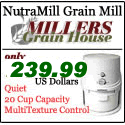|
|
3 Important Differences Between White Bread and Whole Wheat
Emily Clark
For any kid who grew up eating doughy, thick Wonder Bread for
lunch, the encouragement by dietitians and nutritionists to
switch to whole wheat bread can be a tough transition.
Bread, like any other part of our diet, is an acquired taste.
Starting out early helps since children are much more adaptable
to accepting foods than adults. This does not mean that children
LIKE as many foods as adults - children are renowned picky
eaters. But if you only expose them to healthy, whole grain foods
they won't have the opportunity to develop a taste for white
bread or other non-nutritious foods.
Adults, however, must learn to change their diet preferences
because of knowledge. Understanding why whole wheat is superior
to white bread can help you feel good about the compromise and
encourage you to make it the standard for your children. Who
knows - you may even like it!
WHAT IS THE DIFFERENCE?
The two biggest differences between white bread and whole wheat
are the processing and the nutritional value.
Flour is made from wheat berries. The wheat berry is made up of
the bran, the germ and the endosperm. All parts are filled with
nutrients and are used in whole wheat flour.
White bread on the other hand, uses only the endosperm - the
starchy inner layer. There is a total of 30 nutrients missing in
white bread. The nutritional difference is immense and has
measurable impact on our health.
WHAT IS THE IMPACT OF SWITCHING?
The fiber content of whole wheat bread has several health
benefits.
Fiber helps the digestive system. It also creates a 'full'
sensation and thus can help with weight control. Research has
been conducted by Harvard and other organizations that shows men
and women who eat high-fiber foods have less heart attacks and
strokes than those who don't.
There is also an increased risk of diabetes in children who eat
refined white flour - a risk that has been proven by the increase
in cases of childhood diabetes.
WHAT DO I LOOK FOR?
Watch out for words like 'wheat flour' or 'enriched wheat flour'
as they can be mostly made from white flour with just a small
amount of whole wheat added in.
Look for 'whole wheat' or other whole grains, like oat. And don't
be mislead by the name of the product. Names like wheat, whole
bran, stoned wheat, 12 grain and others are still mostly white
flour. The only way to know for sure is to read the label.
The information contained in this article is for educational purposes
only and is not intended to medically diagnose, treat or cure any
disease. Consult a health care practitioner before beginning any
health care program.
Emily Clark is editor at %26lt;a target="_new" href="http://www.lifestyle-health-news.com"%26gt;Lifestyle Health News and %26lt;a target="_new" href="http://www.medical-health-news.com"%26gt;Medical Health News
where you can find the most up-to-date advice and information on
many medical, health and lifestyle topics.
|
Our Food Supply is in Peril! Watch this
Video...
WE RECOMMEND

Here are even more informative articles on milling grains and whole wheat.
The Secrets Of Great Breads
Ive Uncovered The Secret To The Most Bizarre Baking Recipes Thatll Reveal How You Can Bake The Best Home-Made Bread Ever.
PINES Wheat Grass. It's real, it's natural, and it's certified organic
Natural Vitamin Sources
Organic Food: Truth or Fallacy?

Nutrimill
Multi-Texture High Speed Grain Mill
BEST
PRICE Available! New and innovative
variable high speed grain mill. Mill grains and beans
into fresh flour in minutes. Get
More Information and Secure ORDER HERE See
Our Special! |
|